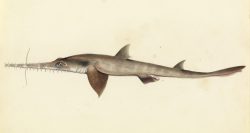select your film:


Mainly known as the Long-nose Sawshark or Common Sawshark, is a Sawshark of the family Pristiophoridae.
Biology and Description:
The Long-nose Sawshark has a slender, slightly flattened body with a very long rostrum that can make up to 30% of its total length. Its colour tends to be pale yellow or greyish-brown on the dorsal side and of white colour on the ventral side, it may have sometimes faint dark blotches, spots, and bars on its back. The barbels of this species are halfway down the rostrum, but slightly closer to the rostral tip than the nostrils. It has about 9-10 large rostral teeth on each side of the rostrum in front of the barbels, 9 behind them. Tooth rows 39-49 in the upper jaw. Dorsal and pectoral fins covered with denticles in large specimens. Its maximum length is 1.37m. Females mature at 113 cm TL, and males at 97 cm TL. This species reproductive mode is ovoviviparous. Long-nose sawshark give birth every other winter to between 6 and 19 pups in a litter. After a 12 month gestation period, pups are born 27-37 cm in length. Their teeth are folded against the snout at birth, which protects the mother from harm. Longnose sawsharks are highly productive in comparison to other shark species, maturing quickly and only living for around 15 years.
Behaviour:
Long-nose Sawsharks hunt in solitary known prey include small fishes and crustaceans. Individuals find prey by running their barbels over the ocean floor. They use the teeth on their snouts to stir up sediment and strike prey.
Habitat:
The Long-nose Sawshark occurs on the continental shelf and upper slope in depths of 40-630 m. This is a moderately abundant endemic species on the continental shelf and, to a lesser extent, the upper slope of southern Australia.
Conservation:
In the shark fishery of southern Australia, the Longnose Sawshark has been retained as a byproduct to the targeting of Tope and Gummy Shark in offshore waters since the mid-1920s and possibly earlier in inshore areas. Several recent general management measures benefit the conservation of the Longnose Sawshark, in particular, fishery restructuring, and spatial management arrangements. Implementation of the Management Plan for the South-East Commonwealth Marine Reserves Network prohibits demersal otter trawl and Danish Seining, and in some areas all other fishing methods, in 14 Commonwealth marine reserves covering a diverse range of temperate marine environments on the continental shelf, continental slope, and abyssal plain.
Do you have images or videos of Long-nose Sawsharks?
Submit them to [email protected].
